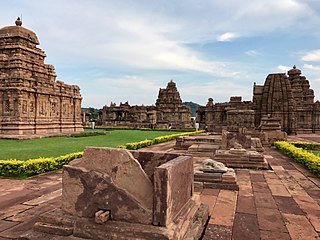
Karnataka, formerly Mysore State, is a state in the southwestern region of India. It was formed as Mysore State on 1 November 1956, with the passage of the States Reorganisation Act, and renamed Karnataka in 1973. The state was part of the Carnatic region in British terminology. Its capital and largest city is Bengaluru (Bangalore).

Indian Institute of Management Bangalore is a public business school and Institute of National Importance located in Bangalore, India. Founded in 1973, it was the third IIM to be established, after IIM Calcutta and IIM Ahmedabad.
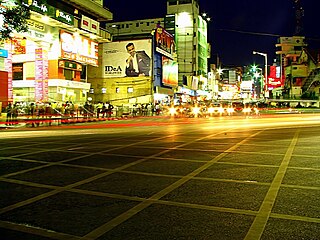
Bangalore Urban district is the most densely populated of the thirty-one districts that comprise the Indian state of Karnataka. It is surrounded by the Bangalore Rural district on the east and north, the Ramanagara district on the west and the Krishnagiri district of Tamil Nadu on the south. Bangalore Urban district came into being in 1986, with the partition of the erstwhile Bangalore district into Bangalore Urban and Bangalore Rural districts. Bangalore Urban has three taluks : Bangalore City, Yelahanka and Anekal. It has seventeen hoblies, 872 villages, eleven rural habitations, five towns, one tier-three city and one tier-one city, administered by ninety-six Village Panchayats , ninety-seven Taluk Panchayats , five Town Municipal Councils (Purasabes), one City Municipal Council (Nagarasabe) and one City Corporation .

Kempe Gowda I, locally venerated as Nadaprabhu Kempe Gowda, or commonly known as Kempe Gowda, was a chieftain under the Vijayanagara Empire in early-modern India. The ruler is famous for the development of Bangalore Town in the 16th century. Kempegowda erected many Kannada inscriptions across the region and also wrote Ganga-gauri-vilasa, a yakshagana (verse-play) in Telugu.

The M. Chinnaswamy Stadium is a cricket stadium in Bangalore, Karnataka, India. It is owned by Government of Karnataka and operated by Karnataka State Cricket Association (KSCA).

Namma Metro, also known as Bengaluru Metro, is a rapid transit system serving the city of Bengaluru, India. It is the second longest operational metro network in India with an operational length of 73.75 kilometers just after Delhi Metro. Upon its inauguration, it became the first underground metro system in South India. Namma Metro has a mix of underground, at grade, and elevated stations. Out of the operational 66 metro stations of Namma Metro as of October 2023, there are 57 elevated stations, 8 underground stations and 1 at-grade station. The system runs on standard-gauge tracks.
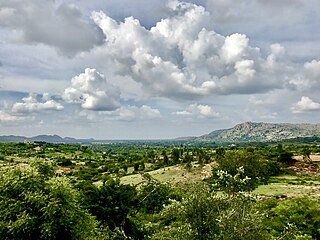
Bangalore Rural district is one of the 31 districts in Karnataka, India. It was formed in 1986, when Bangalore District was divided into Bangalore Rural and Bangalore Urban. Presently in Bangalore Rural district, there are 4 talukas: Devanahalli, Nelamangala, Doddaballapura, Hoskote. It has 20 hoblies, 294 villages, 3 towns, 2 tier-three cities, administered by 66 Village Panchayats , 3Town Municipal Councils (Purasabes) and 2 City Municipal Councils (Nagarsabes).

Kempegowda International Airport is an international airport serving Bangalore, the capital of Karnataka, India. Spread over 4,000 acres (1,600 ha), it is located about 30 kilometres (19 mi) north of the city near the suburb of Devanahalli. It is owned and operated by Bengaluru International Airport Limited (BIAL), a public–private consortium. The airport opened in May 2008 as an alternative to increased congestion at HAL Airport, the original primary commercial airport serving the city. It is named after Kempe Gowda I, the founder of Bangalore. Kempegowda International Airport became Karnataka's first fully solar powered airport, developed by CleanMax Solar.

Bangalore University (BU) is a public state university located in Bangalore, Karnataka, India. The university is a part of the Association of Indian Universities (AIU), Association of Commonwealth Universities (ACU) and affiliated by University Grants Commission (UGC). Bangalore University is accredited by the NAAC with grade A++ in 2023 under the new grading system. Bangalore University was trifurcated into Bengaluru City University and Bengaluru North University.
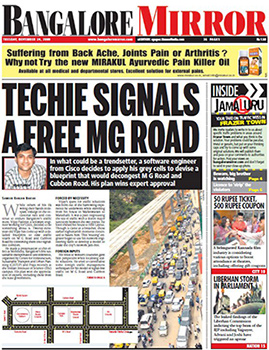
Bangalore Mirror is an English-language daily published by The Times Group in Bangalore, India, as a compact newspaper. It is a deputed newspaper and is the second-largest circulating English daily in the city. In 2020, as part of its Covid-19 downsizing drive, The Times Group merged other editions of Mirror into a weekly affair, except Bangalore Mirror. Bangalore Mirror continues to be the leading daily catering to the tabloid/compact newspaper segment in the young metropolis, focusing largely on original stories that matter to Bengaluru, and its young urban population.

Krantivira Sangolli Rayanna (Bengaluru Station), commonly known as KSR Bengaluru Station, Bengaluru City Railway Station or Bangalore City Railway Station or Majestic Railway station (station code: SBC), is the main railway station serving the city of Bengaluru, Karnataka, India. It is the busiest railway station in South Western Railway zone of Indian Railways, and is the only station classified under NSG1 category in the zone.

Bangalore Fort began in 1537 as a mud fort. The builder was Kempe Gowda I, a vassal of the Vijaynagar Empire and the founder of Bangalore. Hyder Ali in 1761 replaced the mud fort with a stone fort and it was further improved by his son Tipu Sultan in the late 18th century. It was damaged during an Anglo-Mysore war in 1791. It still remains a good example of 18th-century military fortification. The army of the British East India Company, led by Lord Cornwallis on 21 March 1791 captured the fort in the siege of Bangalore during the Third Mysore War (1790–1792). At the time the fort was a stronghold for Tipu Sultan. Today, the fort's Delhi gate, on Krishnarajendra Road, and two bastions are the primary remains of the fort. A marble plaque commemorates the spot where the British breached fort's wall, leading to its capture. The old fort area also includes Tipu Sultan's Summer Palace, and his armoury. The fort has provided the setting for the treasure hunt in the book Riddle of the Seventh Stone.
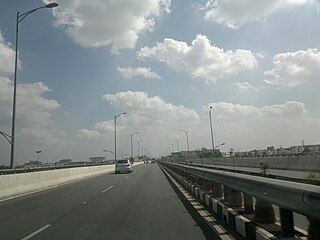
The Electronic City Elevated Expressway is a 9.985 km (6.204 mi) long elevated highway from Silk Board junction to Electronic City in Bangalore, India. The project was is part of the BETL, project as part of the National Highways Development Project and the Elevated Highways Project. It was initiated in early 2006, and was inaugurated on 22 January 2010. It starts from Roopena Agrahara after the Central Silk Board flyover and goes up to Electronic City. It goes above the BMIC flyover, at a height of 17 m (56 ft), thus making it Bangalore's tallest flyover.

Yesvantpur Junction railway station also Yeshwanthapura Junction railway station is one of the three important stations which serves the city of Bangalore which is located in Yesvantpur locality. It is one of the developing stations of Bangalore created for reducing the rush at Bangalore City railway station.
The Bangalore Football League is organised by the Bangalore District Football Association (BDFA), which is affiliated to the Karnataka State Football Association (KSFA) as a ladder-based state football competition involving a total of four divisions and over 130 teams in the Indian state of Karnataka. Bangalore Super Division is the top-division, started in 2001. The winner is awarded George Hoover trophy. Prior to 2001, the Bangalore A Division was the top tier, which currently act as 2nd tier of the state leagues ladder.

Bengaluru Cantonment railway station, also known as Bangalore Cantonment railway station is one of the three important railway stations serving the city of Bangalore and it is located in the locality of Vasanth Nagar and nearby to Shivajinagar. The Station started operations in 1864, with the launch of the Bangalore Cantonment – Jolarpettai train services by the Madras Railway. The train line was broad-gauge and 149 km long, connecting the Bangalore Cantonment with Vellore district. A total of 119 passenger trains start/end/pass through Bangalore Cantonment railway station. Total 499 stations are directly connected to Bangalore Cantonment railway station via these 269 passenger trains.

Bangalore, officially Bengaluru, is the capital and largest city of the southern Indian state of Karnataka. It has a population of more than 8 million and a metropolitan population of around 11 million, making it India's third most populous city and fifth most populous urban agglomeration, as well as South India's second-largest urban agglomeration, after Chennai and the 27th largest city in the world. Located on the Deccan Plateau, at a height of over 900 m (3,000 ft) above sea level, Bangalore has a pleasant climate throughout the year, with its parks and green spaces earning it the reputation of India's "Garden City". Its elevation is the highest among India's major cities.
















